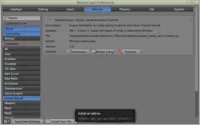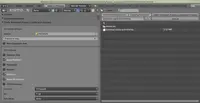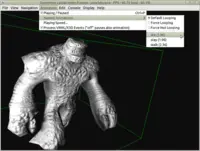Castle Animation Frames (castle-anim-frames) file format
 |
 |
 |
*.castle-anim-frames is deprecated right now.
Instead use glTF for all your animations needs,
it has already excellent support in 3D modeling software like Blender.
Contents:
1. Introduction
Files with extension *.castle-anim-frames
(older version: *.kanim)
represent "Castle Game Engine's Animation Frames".
White Dune
also can generate *.kanim files
from an VRML animation by interpolators.
2. Advantages and Disadvantages
The format is a series of static 3D frames. They can be inlined in a large XML file (as X3D or glTF), or they can be external files (in which case they can be any 3D format supported by the Castle Game Engine). Animation shows the transition from the first frame to the last. Where models are structurally equal, intermediate frames are created by a linear interpolation to show smooth changes.
All the advantages and disadvantages of this format come from this simplicity. On one hand, it can be used to transfer any Blender animation to Castle Game Engine. On the other hand, it can be quite heavy: loading large animations takes some time, and they eat a significant amount of memory.
Some of these disadvantages may be mitigated in the future (as we will internally convert it to better X3D interpolator nodes). But it will always remain somewhat "heavy solution".
At the same time, it will always remain something that can handle any Blender animation, right now. As opposed to the X3D exporter (that currently cannot export Blender animation at all, and in the future will support a limited subset of Blender possibilities).
A disadvantage: we do not interpolate at runtime using nice X3D interpolators. Instead, we generate a series of frames at loading, merge the tree when nodes are equal, and move through them using X3D Switch and IntegerSequencer. We planned to improve this (to improve memory usage and make animation always perfectly smooth at runtime and the collision detection account for dynamic changes)... but the format is deprecated now, no new work is planned. Use glTF for animations instead.
3. Exact Specification
<?xml version="1.0"?>
<animations // Root node should be "animations".
// It should contain any number (at least one)
// "animation" nodes inside.
// For backward compatibility,
// old (single-animation) files may also
// use "animation" as the root node.
<animation // A single animation.
// All it's attributes are optional
// (default values are shown below).
// Some of it's attributes should be treated like a
// "hint for the renderer". General programs like
// Castle Model Viewer may honor them,
// but more specialized programs (like "The Castle"
// game) may ignore them, since "they know better".
name="animation" // Animation name.
// To be used e.g. with TCastleScene.PlayAnimation.
scenes_per_time="30" // If the animation will be "baked":
//
// Suggested number of scenes per time to be generated.
// This is a hint for the renderer — by default it's
// 30, but it may be ignored. Larger values make
// animation smoother, but also much more memory consuming.
// Special value 0 is allowed here, and means
// that animation will simply show each <frame>,
// suddenly changing into the next <frame>,
// without any smoothing of transitions with
// intermediate scenes.
equality_epsilon="0.001"
// If the animation will be "baked":
//
// Epsilon to use when comparing animation frames
// and deciding which parts didn't move at all between
// two adjacent frames. You can set this even to literal
// "0.0", but this may cause a lot of memory to be wasted
// when loading large animation. It's better to set
// this to some very small value — so small that you're
// sure that user will not notice such small move
// anyway.
loop="false" // Should the animation loop? This is a hint for
// the renderer, and may be ignored. Allowed values
// are "false" and "true", not case-sensitive.
// When this animation is used for creature/item in game,
// this is ignored.
backwards="false" // Should the animation go backwards after going
// forward? Allowed values
// are "false" and "true", not case-sensitive.
// When this animation is used for creature/item in game,
// this is not ignored.
>
// A number of <frame> nodes should follow. At least one is required.
// Note that exactly one <frame> node will actually define a still scene,
// you need at least 2 frames if you want a real animation.
<frame
url="file_1.x3d" // This specifies the URL from which to load this
// animation frame. Any 3D file format is allowed here:
// most of all, VRML/X3D, but also
// other formats supported by Castle Game Engine.
// There is also a deprecated attribute "file_name"
// that means the same as "url".
//
// This attribute may be omitted, in which case
// we expect the <frame> element to contain the model
// inlined, in format indicated by mime_type.
mime_type="model/x3d+xml"
// In case the frame content is inlined
// (url is not set), this indicates the inlined model format.
// For now we only allow "model/x3d+xml" (X3D XML)
// or "model/gltf+json" (glTF JSON).
time="0.0" // This is a required attribute specifying a
// time of this frame. For now, all frames
// must be specified in the strictly increasing order
// of their "time".
// This is understood to be in seconds.
bounding_box_center="0 0 0"
bounding_box_size="-1 -1 -1"
// Bounding box of this animation frame.
// Used for collision detection.
// Empty if not specified, or if any size
// component is negative.
//
// This is consistent with X3D bboxSize/Center
// fields definition e.g. at X3D Group node.
/>
// For example, assume that the second <frame> node follows.
// So this defines an animation that changes from
// file_1.x3d and file_2.x3d in exactly 1 second.
<frame url="file_2.x3d" time="1.0" />
</animation>
// More animations follow, if you want:
<animation name="another_animation">
<frame url="another_animation_frame_0.x3d" time="0.0" />
<frame url="another_animation_frame_1.x3d" time="1.0" />
</animation>
<animation name="yet_another_animation">
<frame url="yet_another_animation_frame_0.x3d" time="0.0" />
<frame url="yet_another_animation_frame_1.x3d" time="1.0" />
</animation>
</animations>